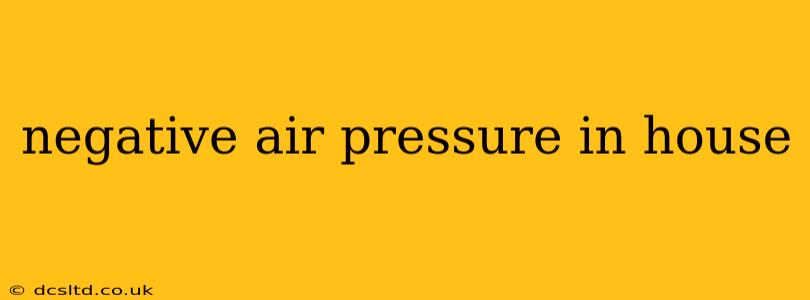Negative air pressure in your home might sound like a minor issue, but it can actually lead to significant problems, impacting your comfort, health, and even the structural integrity of your house. Understanding the causes, consequences, and solutions is crucial for maintaining a healthy and comfortable living environment. This comprehensive guide will delve into the intricacies of negative air pressure, answering your most pressing questions.
What Causes Negative Air Pressure in a House?
Negative air pressure occurs when the air pressure inside your house is lower than the air pressure outside. This pressure difference creates an imbalance, drawing air inwards through any available openings. Several factors can contribute to this imbalance:
-
Powerful Exhaust Fans: Exhaust fans in bathrooms, kitchens, and dryers remove air from your home. If these fans are exceptionally powerful or run for extended periods without sufficient intake air, they can create a negative pressure situation.
-
Leaky Ductwork: Leaks in your HVAC system's ductwork allow air to escape, reducing the internal pressure. This is a common culprit, often unnoticed until problems arise.
-
Improperly Sealed Windows and Doors: Gaps around windows and doors provide pathways for air to escape, slowly contributing to negative air pressure. Older homes are particularly susceptible.
-
High Wind Speeds: Strong winds can exert pressure on the exterior of your home, making it harder for air to escape and contributing to a pressure imbalance.
-
Air Sealing Improvements (Without Balancing): While sealing air leaks is generally beneficial, if done without also increasing the amount of fresh air coming into the home, it can inadvertently lead to negative air pressure.
What are the Problems Associated with Negative Air Pressure?
The consequences of sustained negative air pressure can be far-reaching:
-
Backdrafting: This is perhaps the most serious concern. Negative pressure can draw exhaust gases from appliances like furnaces, fireplaces, or water heaters back into your living spaces, posing a significant health risk due to carbon monoxide poisoning.
-
Increased Energy Bills: Your HVAC system will work harder to compensate for the air loss, leading to higher energy consumption and increased costs.
-
Infiltration of Pollutants: Unwanted outdoor air, carrying pollutants like dust, pollen, and allergens, will be drawn into your home through cracks and gaps, negatively impacting indoor air quality.
-
Dry Air: The constant outflow of air can lead to dry indoor air, particularly during the winter, exacerbating respiratory problems and causing discomfort.
-
Structural Damage (in extreme cases): Severe and prolonged negative pressure can potentially lead to structural problems by increasing the stress on walls, ceilings, and foundations.
How Can I Tell if My House Has Negative Air Pressure?
Several signs might indicate negative air pressure:
-
Strong drafts near windows and doors: Feeling noticeable drafts, even with windows and doors seemingly sealed, can be an indicator.
-
Unusual smells: Noticeable odors from outside entering your home, especially sewer gases, are a serious warning sign.
-
Flickering flames in gas appliances: If the flames in your gas appliances fluctuate more than usual, it could signify backdrafting due to negative pressure.
-
Problems with exhaust fans: Fans taking longer to exhaust air or struggling to perform their function could be a symptom of the imbalance.
How Do I Fix Negative Air Pressure in My House?
Addressing negative air pressure involves identifying and fixing the underlying causes. Several strategies can be employed:
-
Seal air leaks: Caulk and weatherstrip around windows, doors, and other potential entry points.
-
Repair leaky ductwork: Professional HVAC technicians can identify and repair leaks in your ductwork. Consider sealing or insulating ducts in attics or crawl spaces.
-
Install air intake vents: Adding fresh air intake vents helps balance the air pressure by providing a source of replacement air for exhaust fans. Consider installing a whole-house ventilation system, such as an Energy Recovery Ventilator (ERV) or Heat Recovery Ventilator (HRV).
-
Reduce exhaust fan run times: Use exhaust fans sparingly and for shorter durations when necessary.
-
Consult an HVAC professional: A qualified HVAC technician can perform a pressure test to assess the severity of your negative air pressure and recommend appropriate solutions.
What is the best way to test for negative air pressure?
The most reliable way to test for negative air pressure is to perform a pressure test using a manometer or a specialized pressure gauge. While DIY methods exist, professional testing provides the most accurate results and helps pinpoint problem areas. A qualified HVAC professional has the tools and expertise to conduct a thorough assessment.
How much does it cost to fix negative air pressure?
The cost of fixing negative air pressure varies significantly based on the extent of the problem and the chosen solutions. Minor fixes, such as sealing air leaks, may be relatively inexpensive, while major repairs, like ductwork replacement or installation of a whole-house ventilation system, can be more substantial. Consulting with professionals will provide accurate cost estimates.
By addressing the underlying causes, you can restore a healthy, comfortable, and safe indoor environment. Remember, a little attention to air pressure balance can make a big difference in the long run.
